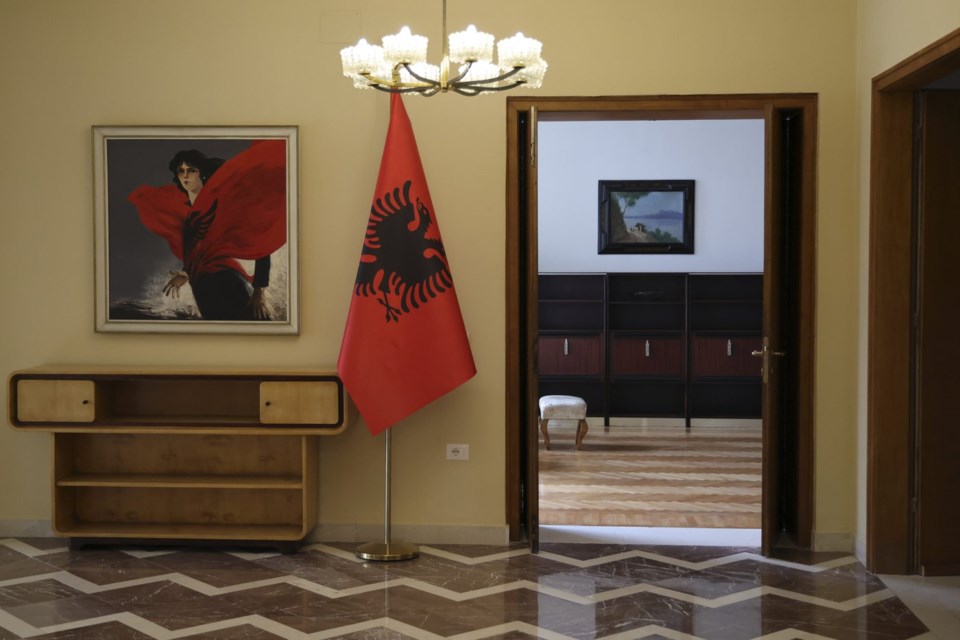TIRANA, Albania (AP) — In a historical twist, the home of Albania’s late communist dictator Enver Hoxha is hosting international artists fascinated by the long-ruling leader’s library, the country’s history of isolation and its unique traditions.
The metamorphosis of Villa 31 — where the Hoxha family lived for decades until his regime was toppled in 1990, five years after his death — encapsulates Albania’s radical transformation from one of the world’s most hermetic countries into the modern society it is today.
The sprawling, 4,000 square meter (43,000 square foot) house with more than 100 rooms, built in the 1970s in the capital of Tirana, was a heavily guarded place of power where Hoxha both ruled and feared his own people. Albania's ruler was known for his paranoid behavior and saw enemies everywhere.
Now surrounded by high-rises, trendy bars, posh restaurants and pulsating nightclubs, the villa itself has undergone a transformation, complete with a fresh coat of paint — though the ostentatious downstairs hall with marble floors is still there.
Gone are the heavy curtains that blocked sunlight. Long silent walls will from now on echo with poetry readings, experimental theater, film screenings and contemporary art exhibits. The rooms offer workshops and shared areas for 23 artists from 15 countries.
The villa's rebirth stems from a pledge by Albanian Prime Minister Edi Rama to visiting French President Emmanuel Macron in October 2023 to turn it into an artists’ center — “something that would make Enver Hoxha roll in his grave.”
Closed off to the public until now, the villa has welcomed artists, residing there since late January, and hopes to soon see tourists too.
“This is what I believe is the power of art, to deal with a past and a painful past, like the one that this villa symbolizes,” said Nita Deda, manager of Art Explora, a French-based foundation that spearheaded the building's transformation.
Inside the studios that replaced once labyrinthine apartments, visiting artists have the freedom to “express everything, from fury to anger, to betrayal, to ambivalence, to the absurd ... exactly his (Hoxha's) worst nightmare,” said Ukrainian artist Stanislava Pinchuk.
Pinchuk, 37, says she is happy to come to Albania, the “last puzzle piece” of former communist countries, though she finds it difficult to sleep at the villa.
She is baffled by Hoxha's library, which holds books by his communist idols — Karl Marx, Friedrich Engels, Joseph Stalin and Vladimir Lenin — to books about the French Revolution and students’ protests in the former Czechoslovakia and Hungary in the 1950s and 1960s. There are also books on sex, which ordinary Albanians were banned from reading at the time.
The library was a testament to “an ideology refusing to die," Pinchuk said.
Reading “Kanun,” a book on Albanian customs, Italian artist Genny Petrotta, 34, marveled at the practice of sworn virgins — a centuries-old tradition in which women declared themselves to be men so they could enjoy the same rights within the society that men enjoyed, though they did not considering themselves transgender.
“It’s a story about power," Petrotta said, adding that she was “impressed by the analytical way” the book described the phenomenon.
The villa’s underground tunnels, built as shelters in case of an attack, also fascinated the visiting artists. Their exhibit will open in April, and Albanians, no longer fearful of the late dictator, will be able to view the art.
Under Hoxha's repressive regime, some 100,000 Albanians were imprisoned, sent to internment camps or executed during the 46 years of his repressive regime.
Albania today has seen its economy and society develop rapidly, and 10 million tourists visited the country last year.
Some, however, disagree with Villa 31's transformation, and say it should have stayed untouched, a history lesson for the tourists and generations born long after Hoxha's regime collapsed.
Xhevdet Lani, a taxi driver and an older resident of Tirana, said the villa is “historic evidence of what the dictatorship once was.”
“It would have been better if it had remained for generations so that our children and grandchildren could learn from it,” he said.
Llazar Semini, The Associated Press



